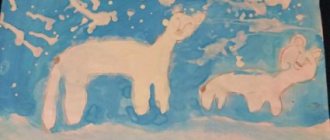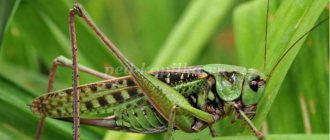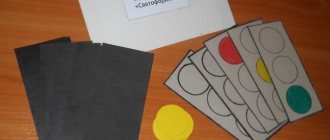Lesson in the senior group of a preschool educational institution. Animals in winter
Summary of a lesson on environmental education for children of the senior group “Animals in winter”
Program content Objectives Educational
To clarify and expand children’s ideas about the lifestyle of forest animals (squirrel, hare, wolf, bear, elk, hedgehog) in winter.
Developmental
Continue to develop attention - Summarize children's knowledge about the typical habits of animals in winter, methods of protection from enemies, obtaining food
Educational:
Foster a caring attitude towards nature and its inhabitants
Preliminary work: Examination of illustrations of wild and domestic animals, conversation Materials and equipment Cards with images of animals ( squirrel, hare, wolf. Images of animal nutrition (tree bark, branches, mushrooms, Cards with images of wild and domestic animals Methodology Stages Contents Note Introductory part Educator: Guys, can you hear? Someone is knocking Guys, look at our door Dunno came to visit them. Educator: Guys, let's say hello to Children: Hello Dunno Dunno: Hello guys Knock on the door, Dunno comes in Main part Educator: Dunno, what's in your hands? Dunno: pictures with images of animals Dunno. These animals live in the forest, but now it’s very cold - winter. Probably, they are also cold and hungry, so I decided to take them home: I will look after them, feed them. Educator: Children, is it possible to take these animals home? Children. No you can not. They need freedom, and at any time of the year they find food for themselves and do not freeze. Educator: Guys, you spoke so well and quickly that Dunno did not understand why the animals are better off in the forest. Let's sit on the chairs and tell him everything, everything about how animals spend the winter. Riddle:
Not a mouse, not a bird frolics in the forest, lives in the trees and gnaws nuts.
Dunno. I know this beast. I saw it in the forest many times in the summer. In winter there is no food for her, we need to take care of her, take her home and feed her, or better yet, put her to sleep until spring. Educator: Is it possible to do this with a squirrel? Children: No. Educator: Where does the squirrel live? Children: in the Hollow Educator: That's right, the squirrel jumps from tree to tree, finds a hollow, insulates it, lives in it. What does it eat? Children: Since autumn she has been storing nuts and mushrooms. How can she escape from her enemies? Children She knows how to quickly move from tree to tree - it is Dunno who saves her. Okay, I'll leave the squirrel in the forest. But I will definitely take this little animal home: he is so small, anyone will hurt him. Educator: Guys, listen and guess the riddle Riddle. White in winter, gray in summer. Children: hare Teacher: That's right, it's a hare How does a hare prepare for winter? Children: Changes fur, color, sheds. What does a hare eat? Children: tree bark, branches Does the hare have enemies? Who ? Children: yes Fox, wolf, Teacher: How does he escape from them? Children: saved by fast legs, coat color. Dunno. Okay, I understand everything and I’ll leave the bunny in the forest too, I won’t take it home. And who else eats bark Educator: Guys, you’re probably tired, let’s take a rest Physical exercise “The deer has a big house” The deer has a big house, (Hands above his head - we represent the roof of the house. He sits, looking out the window. We prop up his cheek with our right fist, with our left We support the right one with our hand. The bunny is running across the field, Running in place. There is a knock on his door: Foot stamping, hands on the belt. “Knock, knock, open the door, Imitation of knocking on the door in turn with each hand. There is an evil hunter in the forest.” Hands on the belt, turn to the right and left. “Bunny, bunny, run! Inviting movement with your hand. Give me your paw.” We stretch out our hands with an open palm) Teacher: Did you like the exercise? Children: yes Dunno. Guys, what other animals live in the forest? Children: Bear, fox, wolf, mole Teacher: right, who will tell me how a hare prepares for winter? Children: changes his fur coat from gray to white Educator: And the bear? Children: the bear goes into hibernation and sleeps until spring Educator: Well done guys, do you know how a fox prepares for winter? By the fall the fox has already raised her cubs, so she does not sit in the hole. But if danger threatens, the fox runs to its house and hides. The fox has a hole at the edge of the forest on a hill so that the fox can see the forest from all sides. The fox is very smart, she never runs straight to the hole, first she makes a loop to confuse her tracks, and then hides in the hole. The fox is a predator; it does not sleep in winter and does not store food for the winter, just like the wolf. But both the fox and the wolf are preparing their fur coat for winter. Their fur, like that of all animals, grows and becomes very warm and fluffy so that it is not cold in winter. Educator: Well done, now Dunno knows what animals live in the forest. What can you call the animals living in the forest? Children: Wild animals Educator: Guys, I invite you to play the game “Fourth Odd.” I will show you animals, and you must tell me which animal is wild or domestic (Wolf, hare, cow, chicken, goose, fox, squirrel, bear, cat, dog, pig, mole) Educator: Well done, you did it. Did you like this game? Children: Yes Children look at the pictures (squirrel, hare, wolf, bear, elk, hedgehog). Children sit on chairs I make a riddle I show an image of a squirrel in a winter forest next to a hollow I talk with the children As questions go, I show images with answers I make a riddle I show an image of a hare eating the bark of a tree I talk with the children I conduct a physical education session As the poem progresses, the children imitate movements I talk with the children I show pictures to the children with images of wild and domestic animals, children determine which group they belong to. Final part Dunno: Guys, now I understand that wild animals live in the forest and they cannot be taken home. Because you helped me figure this out, I want to give you these coloring pages with animals. And now it's time for me to return home. Goodbye guys, see you again Children: goodbye Dunno Dunno thanks the children and gives coloring books Children say goodbye to Dunno
Summary of a lesson on environmental education for children of the senior group “Animals in winter”
We recommend watching:
Summary of a lesson on the surrounding world for the senior group “Hello, Zimushka-Winter!” Summary of a lesson for older preschoolers “Hello, winter - winter” Summary of GCD in the senior group: How animals prepare for winter Summary of GCD on cognitive development in the senior group on the topic: Winter
Similar articles:
Summary of the lesson “Birds in winter.” Senior group
Summary of a lesson on ecology in the senior group in kindergarten. Birds in the forest
Summary of a music lesson in kindergarten in the senior group on the topic: Winter
Entertainment “Visiting Winter” in kindergarten in the senior group
Walk “Wind Watching” in the senior group
Lesson “Record-breaking animals”
Author of the lesson: Davydova Svetlana Alekseevna.
Lesson objectives:
Expand children's knowledge about some representatives of the fauna. Form stable ideas about the importance of all living creatures living on Earth. Dictionary: record holder, names of animals. Practice counting and numbering the result of counting, and the ability to measure the length of an object using a ruler. Improve your sculpting skills. Develop memory, attention, fine and gross motor skills.
Foster an ecological worldview.
Equipment:
Globe. Pictures: blue whale, reticulated python, large kangaroo, elephant, ostrich, giraffe, cheetah, penguin. Worksheet with tasks “Find the odd one out”, “Circle the dots”, “Shade the pen”, “Draw how a kangaroo jumps”, “Measure the giraffe’s neck”, “Count the penguins”, “Go through the maze”.
Rulers, pencils, plasticine, stacks, modeling boards.
Worksheet for the lesson “Record-breaking animals.”
The second sheet is an assignment for the lesson “Record-breaking animals.”
Progress of the lesson:
“Nature never ceases to amaze us with beautiful flowers, amazing creatures, and magnificent views. Now you have another meeting with the amazing world of nature.
- Animals, birds, insects, fish are very necessary for us - people. Let's think about why exactly people need them. They provide us with food: meat, milk, eggs, honey. They provide us with clothing: wool, fur. They can become true friends and helpers: dogs, cats, horses.
Without them, the world will not be so interesting and beautiful.
— Today we will learn about record-breaking animals. Who is the record holder? A record holder is someone who has distinguished himself in something and has become the very best. Today we will learn a lot of new and interesting things about such animals and birds. Who is the biggest, tallest, heaviest, fastest. And at the same time we will complete various tasks.
- The largest animal in the world lives not on land, but in water - it is the blue whale. It is larger than the largest of the dinosaurs. The blue whale is so long that eight elephants can stand in a row on its back.
Exercise “Find the odd one out”
—Which whale in the picture is different from the others?
— The elephant is the largest animal living on land. He weighs as much as seven cars and is three times taller than each of you. Elephants greet each other by shaking their trunks. After all, an elephant’s trunk is also a “hand” with which it can pick up even such small objects as buttons from the ground. Elephants live in Africa and Asia. (Display on the globe).
Exercise “Circle the dots”
- Connect the dots to make an elephant.
— The ostrich is the tallest and heaviest bird in the world. This bird is as tall as a bus. Ostriches cannot fly, but they run fast.
— Ostriches live in Africa and South America. (Display on the globe).
Exercise “Shade the pen”
Children do shading according to the pattern.
— The large kangaroo is the record holder for jumping among animals. The kangaroo will easily jump over each of you, and if he wants, he can jump over me too. The kangaroo has very strong hind legs, which it uses to push itself off the ground. A kangaroo runs with big leaps and can catch up with a galloping horse. Kangaroo lives in Australia - here it is on the globe (display).
Exercise “Draw how a kangaroo jumps”
Children first trace an arcuate line, then continue it themselves.
— The giraffe is the tallest animal living on earth. He has such a long neck that he can easily reach the roof of our kindergarten (the roof of the second floor). The giraffe lives in Africa. This is Africa. (Display on the globe).
Exercise “Measure the giraffe’s neck”
- Take a ruler in your hands and measure the length of the drawn giraffe’s neck.
— Birds that live in the coldest place on Earth are the penguins of Antarctica. This is where Antarctica is. (Display on the globe). Penguins are excellent swimmers; they dive from ice floes into cold water, where they catch fish, shrimp, and squid for lunch.
Didactic game “Count the penguins”
- Count the penguins on each ice floe and connect a line to the corresponding number.
Dynamic pause
A huge, smart, kind elephant Sends his respects to everyone. He nods his head and gets to know you.
- (Feet shoulder-width apart, arms bent at the elbows raised and spread to the sides, head tilted)
- Putting paw to paw, keeping up with each other, the penguins walked together in a row, like a small squad.
- (Walk with a small mincing step, put your heels to your heels, toes are apart, arms are lowered and pressed to the body, the body sways slightly to the right and left)
The kangaroo jumps so fast, like my favorite ball. Turn right and left, jump back, then forward.
(Bend your elbows, perform light jumps left and right, back and forth)
Here is a snake, it scares and won’t let you near it. She crawls along the ground, wriggles slightly.
(Wave-like movements with the left hand, then the right, then the whole body)
— The cheetah is the fastest animal on Earth. A hungry cheetah, chasing prey, can rush at speeds of more than 100 kilometers per hour, overtaking a car. But such fast running tires the cheetah very much, so he has to stop to rest. A cheetah pushes off the ground with its sharp claws while running.
Cheetahs live in Africa and Asia. (Display on the globe).
Exercise “Go through the labyrinth”
— Help the cheetah get to its prey.
— The reticulated python is the longest snake in the world. Python is not a poisonous snake. It grows up to 10 meters long - that's six bicycles placed in a row. It crawls on the ground, but is good at climbing trees. Pythons hide during the day and hunt small animals at night. The female python lays eggs, wraps rings around them and thus warms and protects her future babies.
— Reticulated pythons live in Asia. (Display on the globe).
Modeling “Reticulated Python”
Children sculpt the thin body of a python by straight rolling, apply a mesh pattern in stacks, lightly squeeze the python’s head, use stacks to make a horizontal incision for the mouth and press in beads for the eyes.






